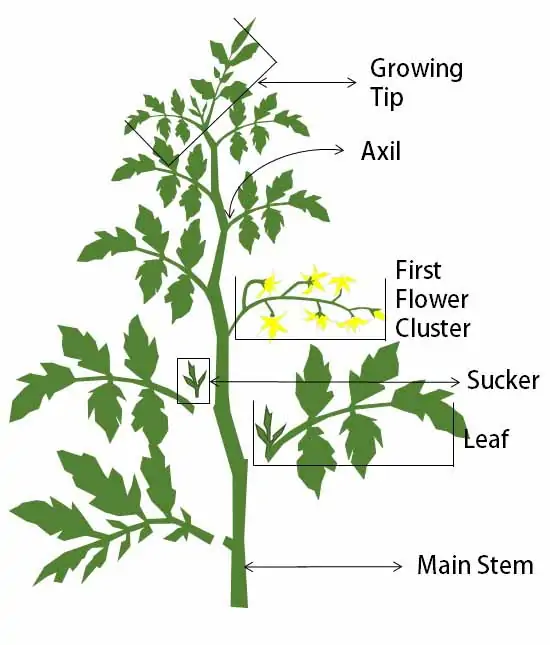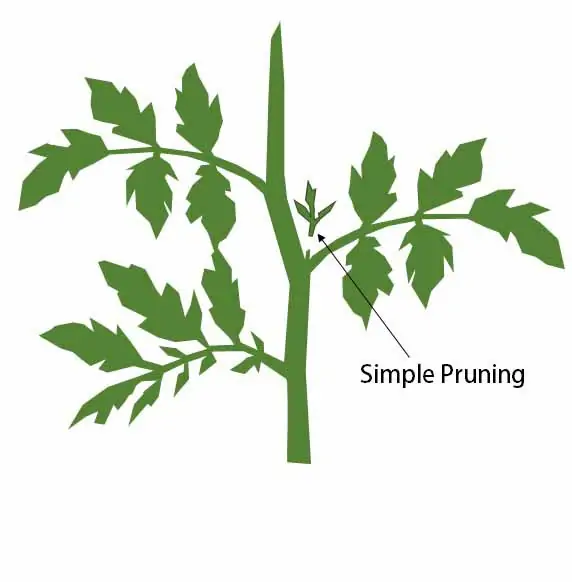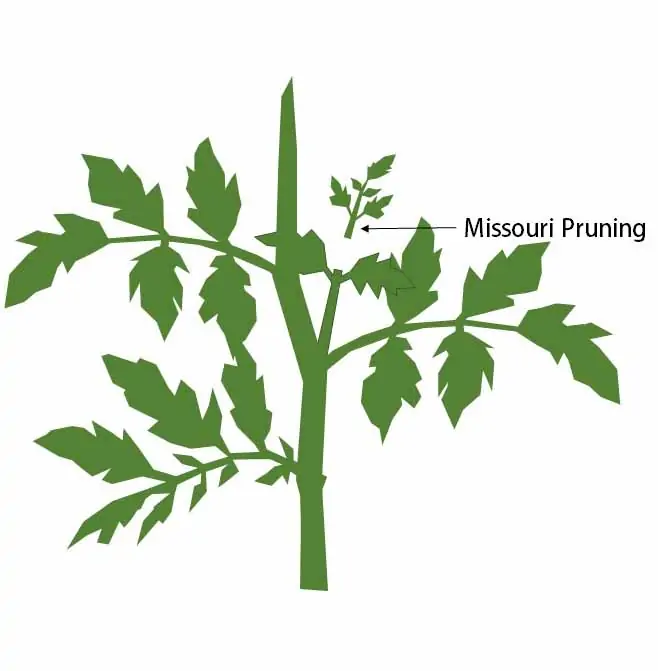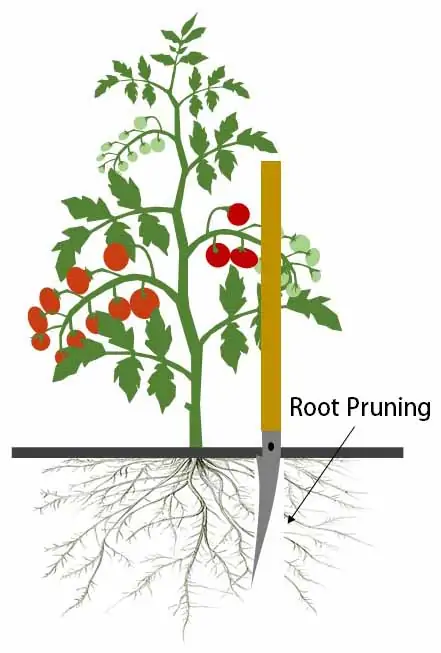Pruning is a common part of tomato plant care. The right time and proper way of pruning tomato plants can bring you the ultimate success in the harvest.
If you are a beginner gardener, you should always be concerned and regularly monitor your tomato plants to see if they need pruning and other assistance to produce healthy fruits.
So, you must learn the right way of pruning tomatoes and their benefits. Besides, the side effects of over-pruning or the wrong way of pruning.

Benefits of Pruning Tomato Plants
Tomato produces a large amount of sugar when they get direct sunlight for about 6-8 hours a day.
Besides, in the first four weeks after recovering from transplanting stress, they show dramatic growth and direct all the sugars to produce new leaves.
In this stage, the plant produces more sugar than a single growing tip can consume. So, the tomato plants start generating new suckers and flowers.
This happens actually when the plants hold around 10 to 14 leaves or grow 12 to 18 inches tall.
After they reach a certain growth, you need to direct the sugars to make flowers and produce healthy fruits rather than leafy plants.
And so, pruning is a good solution for better yield. Besides, there are some other benefits are follows:
Develop Plant Structure and Health:
Proper pruning develops the tomato plant’s structure and overall health condition.
Tomato plant leaves grow very densely when they get the perfect growing condition.
These densely growing leaves prevent normal airflow and create permanent shade to the leaves behind the front leaves.
Therefore, they are unable to make photosynthesis due to the lack of direct sunlight.
As a result, the leaves behind the front leaf consume more sugar than they produce and eventually turn yellow and drop off. They also invite some diseases.
The right way of pruning makes enough room between the leaves and helps to produce more sugar for fruit development. Besides, it also helps to reduce the risk of some diseases and ensure a healthy plant.
Provide More Nutrients:
Excessive foliage grabs nutrients that tomato plants need to produce fruits. Pruning provides more nutrients to develop healthy fruits rather than produce more foliage.
So, pruning unnecessary tomato plant suckers and leaves makes a big harvest.
Increase Air Circulation:
Air circulation is very essential for tomato plants for good pollination and humidity control.
Moreover, it helps to dry tomato leaves quicker after rainfall.
Both high and low moisture hampers fruit production and is prone to some diseases.
Keep Safe from Diseases:
Pruning reduces the risk of some soil-borne diseases and other tomato plant problems.
Lower and older leaves of tomato plants are more susceptible to some soil-borne fungal diseases.
Besides, extreme foliage may reduce the harvest and attract various pests and diseases.
Early Harvesting:
Pruning helps quick fruit development and matures the fruits a little earlier than the exact mature date. It can make the harvest one or two weeks earlier.
If you have a shorter growing season, pruning will get you the harvest in advance.
Larger Fruits:
Tomato fruits need more nutrients during flowering and plant development. If you prune your tomato plants on time following the proper way, then your tomatoes will become larger.
Quality Fruits:
Proper pruning improves the structural strength of your tomato plants and makes them look vigorous. As a result, they produce healthier, testier, juicy tomato fruits.
Different Types of Pruning Methods
Simple pruning
Allow cutting young suckers, which produce weak fruits and drain away from the energy from the main stem.
This method performs well in the early season during flowering time.

Missouri Pruning
This is a modified technique of simple pruning which cuts off the tips of each sucker above the first fruit cluster.
This performs better in the warm zone and for larger suckers.

Root Pruning
Allow cutting the roots with a spade around 8-12 inches away from the base of the plant. Penetrating the soil 8-10 inches surrounding interrupt the plant’s growth and force it to mature earlier.
Performs better after ripening a few fruit clusters.

Top Pruning or Topping
Cut off the tips of the tomato plants above the last flower cluster about four weeks before the first frost.
It encourages the tomatoes to mature earlier.

How to Prune Tomatoes Step by Step
Indeterminate tomato varieties are usually suitable for pruning due to their vine-type growth. They continue growing and producing fruits until the first frost kills them.
Therefore, you need to continue pruning until the end of the season. But you need different types of pruning in different stages of plant growth.
Stage 1: Pruning Tomato Seedlings during Transplant
Before transplanting tomatoes, remove the lower leaves except for the top four leaves or the tip of the seedlings.
Plant your tomatoes as deep as you can. You should bury almost 2 parts out of 3-parts of a tomato seedling during transplant to develop a strong root system.
You should pinch off the flower cluster if they present during the transplant. This will help the plants to focus the full energy spent on developing a foliar system in the early stages of plant growth.
Stage 2: Simple or Missouri Pruning during Mid-season
Prune the flower cluster if they appear before the plants become 12 to 18 inches tall or hold 10 to 14 leaves on the stem, depending on the tomato varieties.
It helps the tomato plants to absorb more energy to develop a strong plant structure to produce larger and healthier fruits.
Removing young suckers is the major part of pruning tomatoes at this stage. Suckers are small shoots that form at the point (commonly known as plant axil) where side leaf branches attach to the main plant stem.
If you want to increase your production sparingly, prune the suckers. It also reduces the risk of sunscald on tomatoes during hot weather conditions.
Pinch off all the suckers under the first fruit cluster when they are small and young. This helps the main stem of tomato plants become stronger.
As well, you should avoid removing the suckers above the first fruit cluster because they will produce more flowers and fruits on plants. This method is commonly known as simple pruning.
There is another method of pruning in this mid-season called Missouri pruning. This is actually a modified technique of simple pruning. It performs better in warmer zones as well as when you have to remove large suckers.
In this method, you can pinch off the tip of each sucker letting only one or two base leaves remain. You can also use pruners to cut them off if they are growing larger.
As these leaves become larger, they will work like shades on the tomato fruits to protect them from sunscald. Besides, leaves that are close to suckers provide more sugar to the tomato fruits than other branch leaves.
Stage 3: Topping or Root Pruning during Late Season
During the end of the growing season, each tomato plant holds a lot of fruits.
If you want to speed up the ripening process, cut off the growing tip of each main stem of the tomato plants.
Count the expected first frost date and remove the growing tips about 30 days before the fall frost.
This process is often called topping. It will stop producing new flowers and fruits on tomatoes and directs all the sugars to the existing fruits. And so, the fruits ripen faster during harvest.
You should skip this step if you prefer more green tomatoes for certain purposes, such as making jelly or frying them.
There is another way of pruning tomato plants in this stage which is called root pruning.
You can start pruning roots after ripening a few tomato clusters. This will interrupt the regular plant growth and force the fruits to become mature earlier.
In this method, you can use a pitchfork, spade, shovel, or a long kitchen knife to cut down plant roots along one side of the main plant stem, 8 to 12 inches away from the main stem and going down about 8-10 inches.
The proper way of pruning roots doesn’t kill the plants but rather encourages the fruits to ripen faster.
How does Pruning Affect Tomato Fruit Size?
Properly pruned tomato plants can produce more sugar to make more fruits.
If you wish to make big-size fruits, only concentrate on a single growing tip and remove all the suckers. This will produce huge sugars to develop bigger fruits under the single growing tip.
On the other hand, if you maintain multiple growing tips, they will distribute sugars to the multiple branches. As a result, the tomato plants will produce more fruits but smaller than single growing tips.
So, a single growing tip means fewer but bigger sizes of tomatoes,
Why Should I Avoid Pruning Determinate Tomatoes?
Typically, determinate tomato plants don’t need any pruning due to they stop growing after a certain length and start producing limited flowers and fruits. And so, pruning determinate tomatoes often decrease fruit production.
However, you can still prune the determinate tomatoes but only the older leaves under the first flower cluster. It helps the plants to protect from some soil-borne diseases.
Pruning and Staking Work Together
Pruning of staking tomatoes is less susceptible to diseases.
Usually, indeterminate tomato plants are pruned due to their continuous growing habit until the end of the season.
So, this type of tomato plant must need staking to stand strong and hold more fruits.
Without any staking, tomato plants will lie down on the ground, which may invite soil-borne diseases.
How to Prune Patio Tomatoes?
According to the growing habit, tomato plants can be divided into two types such as determinate and indeterminate varieties.
Determinate tomatoes are the bushier type that stops growing after a certain length and starts making fruits. Patio tomatoes are the mainly determinate type that is best suitable for containers or growing pots.
Due to their growing habit, patio tomatoes or potting tomatoes need no pruning. You can only remove the lower leaves under the first flower cluster.
On the other hand, pruning works well with indeterminate tomatoes and makes the best out of it.
How to Prune Big Tomato Plants?
- Prune the lower leaves (under the first flower cluster) from both determinate and indeterminate tomatoes.
- Remove the leaves if they touch the ground.
- As the plants continue growing (Indeterminate), you can also cut off the lower leaves sparingly up to 18 inches from the soil surface to avoid any soil-borne diseases.
- Avoid working in the field when the leaves are wet.
- Clip away some leaves to lessen the density from the middle of caging tomato plants. It will increase airflow to reduce the risk of diseases.
- Never remove the closest leaves from above or below a fruit cluster. Both the leaves can produce sugar, and the upper leaves can give shade to the fruits.
Disadvantages of Pruning Tomatoes
- Pruning tomatoes may reduce the overall production but larger fruit.
- It creates scars on the tomato plants which can invite pests and diseases.
- Over-pruning can develop sunscald on tomatoes.
- Besides, pruning in warm weather conditions like zone 9 or higher may also cause sunscald.
- Improper pruning may also cause blossom end rot.
- Pruning is time-consuming, which you can use on other gardening works.
Conclusion:
Pruning is not compulsory for all types of tomato plants. Even you can grow better yield without any pruning.
Sometimes pruning brings you success, but it can also damage your plants if you don’t follow the right way of pruning.
But mild pruning (cutting off lower leaves beneath the first fruit cluster or which touches the ground) always works, and it doesn’t bring any trouble for your tomatoes.
So, whether your tomatoes need pruning or not mainly depends on your plant structure, tomato varieties, the purpose of use, garden location, planting zone, and overall experience in growing tomatoes.
|| People who read this article often read
- 20 Helpful Tips for Pruning Tomato Plants
- How to Support Tomato Plants the Ultimate Guide
- How to Trellis Tomato Plants the Ultimate Guide
- 4 Secret Tips of Staking Tomato Plants
- How to Water Tomato Plants: From Seedbed to Harvest
- How To Fertilize Tomatoes: From Planting To Harvest
- 10 Reasons to Pick Determinate Vs. Indeterminate Tomatoes
- How to Ripen Green Tomatoes Off the Vine: 5 Helpful Methods
- Six Ripening Stages of Tomatoes by the Fruit Surface Color
- When and How to Pick Tomatoes: Right Time and Way to Harvest
- When Where and How to Save Tomato Seeds: The Ultimate Guide
- How to Make High Nutrients Homemade Fertilizer for Tomatoes
- How to make a homemade organic potting mix for tomatoes
- How to transplant tomato seedlings safely
- A Helpful Guide to Prepare Soil for Tomatoes
- A Helpful Guide to Grow Tomatoes in Containers
Leave a Reply